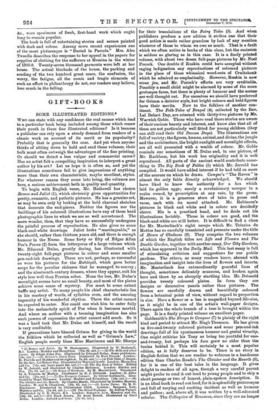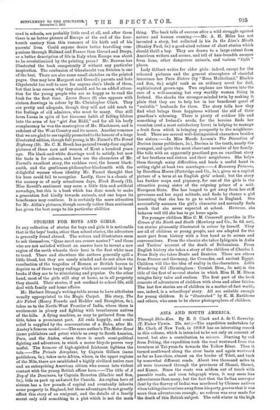GIFT-BOOKS
SOME ILLUSTRATED EDITIONS.* Wito can state with any confidence the real causes which lead to a particular book being included among those which renew their youth in these fine illustrated editions P Is it because a publisher can rely upon a steady demand from readers of a classic work on account of its merit or its popularity? Probably that is generally the case. And yet when anyone thinks of sitting down to hold and read these volumes, their bulk must often outweigh the advantages of the fine printing. Or should we detect a less vulgar and commercial cause P Has an artist felt a compelling inspiration to interpret a great author by his art ? Let us hope it is often so, and yet the illustrations sometimes fail to give impressions of anything more than their own characteristic, maybe excellent, styles. For whatever reason they come into being, the volumes are here, a serious achievement both in quality and quantity.
To begin with English verse, Mr. Hatherell has chosen Romeo and Juliet (1), which obviously gives opportunities for pretty, romantic, and pathetic pictures. He has a genuine art, as may be seen only by looking at the bold charcoal sketches that decorate the end-pieces. Neither the figures nor the buildings of his coloured illustrations have any of those hard photographic lines to which we are so well accustomed. The more wonder, then, that they have so successfully undergone the painful process of reproduction. He also gives us some black-and-white drawings. Juliet looks "marriageable," as she should, rather than thirteen years old, and there is enough humour in the Nurse. Some forty or fifty of Edgar Allan Poe's Poems (2) form the letterpress of a large volume which Mr. Edmund Dulac, greatly daring, has illustrated with twenty-eight full-page pictures in colour and some smaller pen-and-ink drawings. These are not, perhaps, so successful as were his pictures for the Bubciiyat, which gave better scope for the peculiar richness that he managed to convey ; and the nineteenth-century dresses, where they appear, suit his style less well than Persian robes. None the less, Mr. Dnlac's moonlight scenes have no small beauty, and most of the plates achieve some sense of mystery. Poe must to some extent baffle any artist. To many people his chief characteristic lies in his mastery of words, of syllables even, and the amazing ingenuity of his wonderful rhythm. There the artist cannot be expected to enter. Nor could one wish him to enter fully into the melancholy spirit of Poe when it becomes morbid. And where an author with a teeming imagination has also such powers of expression the artist cannot add much. So it was a bard task that Mr. Dulac set himself, and the result is very creditable.
If generations have blessed Grimm for giving to the world the folklore which he collected as well as "Grimm's Law," English people surely bless Miss Martineau and Mr. Sharpe
• (1) Romeo and Juliet. By W. Shakespeare. Illustrated by W. Hatherell, R.I. London Hodder and Stoughton. [10s. 6d. net.]-(2) The Bells and other Poems. By Edgar Allan Poe. Illustrated by Edmund Duke. Same publishers.
5s
[1. net. -(3) Crrimm's Fairy Tates. llustrated by Noel Pocock. London : IL Frow e and Hodder and Stoughton. 7s. 6d. net.]-(4) Folk-Tales of Bengal. By the Rev. LalBehari Day. Illustrated by Warwick Goble. London: Macmillan and Co. [158. net, large paper 423. net.]-(5) The Big Book of Fables. Edited by W. Jerrold, and illustrated by Charles Robinson. London: 13Iackie and Son. [78. 6d. net.]-(6) Hours of Gladness. By M. Maeterlinck. Translated by A. Teixeira de liattos. Illustrated by E. J. Detmold. London : G. Allen and Co. 121s. net.]-(7) She Stoops to Conquer. By Oliver Goldsmith. Illus- trated by Hugh Thomson. London : Hodder and SLoughton. [L5s. net.}-(8) The Cloister and the Hearth. By Charles Beade. Illustrated by Gordon Browne. London W. and R. Chambers. [108. 6d. net.]-(9) Lorna Doane. By R. D. Blackmore. Illustrated by Christopher Clark. London : Sampson Low, Marston and Co. [7s. 6d. net.]-(10) The Broad Highway. By JeeyFarnol. Illustrated by C. E. Brock, R.L London : Sampson Low, Marston and Co. [10s. 6d. net.)-(11) Black Beauty. By Anna Sewell. Illustrated by Cecil Aldin. London : Jarrold and Sons. [7s. Ed. net.]
for their translations of the Fairy Tales (3). And when publishers produce a new edition it strikes one that their good action is made rather graceless by lack of any mention whatever of those to whom we owe so much. That is a fault which we often notice in books of this class, but the omission is seldom so glaring as in this case. It is a finely printed volume, with about two dozen full-page pictures by Mr. Noel Pocock. One doubts if Ruskin could have accepted without raging indignation any reproductions of coloured pictures in the place of those whimsical wood-cuts of Cruikshank which he admired so emphatically. However, Ruskin is now vieux jev„ and Mr. Pocock's efforts are very creditable. Possibly a small child might be alarmed by some of the more grotesque faces, but there is plenty of humour and the scenes are well thought out. For ourselves we should have preferred for Grimm a daintier style, but bright colours and bold figures have their merits. Now to the folklore of another con- tinent. The .Folk-.Tales of Bengal (4), collected by the Rev. Lal Behari Day, are reissued with thirty-two pictures by Mr. Warwick Goble. Those who have read these stories are aware of their curious beauty and interest, and know also that all of them are not particularly well fitted for young children (they can still read their Old Deccan Days). The illustrations are full of variety; the figures, human, animal, and divine, the jangle and the architecture, the bright sunlight and moonlight effects, are all well presented with a wealth of colour. Mr. Goble reminds one sometimes of H. Dulac and, in one picture, of Mr. Bockhorn, but his work has originality and it is well reproduced. All parts of the ancient world contribute some- thing to The Big Book of Fables (5) which Mr. Jerrold has compiled. It would have added interest if he had told us more of the sources on which he draws. Cowper's "The Raven" is almost the only fable directly acknowledged. We should have liked to know the authority for a hen which laid its golden eggs; surely a revolutionary usurper in a realm owned, by prescription at any rate, by the goose. However, it is a generous store of tales in prose and verse, each with its moral attached. Mr. Robinson's pictures in black and white and in colonr are decidedly clever. His is a practised hand, and he deals out his illustrations lavishly. Those in colour are good, and the black-and-white are still better. It is difficult to find a class for Mr. Maeterlinck's eight essays which Mr. Teixeira de Mottos has so carefully translated and presents under the title of Hours of Gladness (6). They comprise the two volumes of which the English titles are Life and Flowers and The Double Garden, together with another essay, Our City Gardens, which has appeared in the Daily Mail. This last essay is full of stimulating criticism and suggestions for our public gardens. The others, as many readers know, abound with imagination and insight into the lives of flowers and insects. Mr. Maeterlinck has extraordinarily graceful lines of thought, sometimes delicately sensuous, and broken again here and there by an abruptly startling idea. Mx. Detmold provides twenty coloured plates. In form they are designs or decorative panels rather than pictures. The flowers are carefully drawn and beautifully coloured from a botanical point of view, without regard to proportion in size. Here a flower or a bee is magnified beyond life-size, as it might be in one of the artist's wall-paper designs. There again the whole branch of a tree is brought within the page. It is a finely printed volume on excellent paper.
Goldsmith's She Stoops to Conquer (7) is plainly of the right kind and period to attract Mr. Hugh Thomson. He has given us five-and-twenty coloured pictures and some pen-and-ink drawings full of his spontaneous humour and genial vivacity. One might criticise his Tony as being too youthful for one. and-twenty, but perhaps his face grew no older than the brains behind it. This will certainly be a most popular edition, as it fully deserves to be. There is no story in Epglish fiction that we are readier to welcome in a handsome edition than Charles Reade's The Cloister and the Hearth (8), for it is one of the best tales in the language. It gives delight to readers of all ages, though a very careful parent might prefer to read it out loud to young people and to skip a short passage or two of honest, plain-spoken description. It is an ideal book to read out loud, for it is splendidly picturesque and full of varying and exciting incident as well as humour and pathos ; and, above all, it was written by a well-educated scholar. The Colloquies of Erasmus, since they are no longer read in schools, are probably little read at all, and after them there is no better picture of Europe at the end of the four- teenth century than this romance of his birth and of his parents' lives. Could anyone desire better travelling com- panions through Holland and France than Gerard and Denys, or a better description of life in Italy when Europe was about to be revolutionized by the printing press ? Mr. Browne has illustrated the book competently if without any particular inspiration. The confession of Ghysbrecht van Swieten is one of the best. There are also some small sketches on the printed pages. One may love Margaret and Gerard's parents and hate Ghysbrecht too well to care for anyone else's ideals of them, but that is no reason why they should not be an added attrac- tion for the young people who are so happy as to read the book for the first time. Lorna Doone (9) also appears with sixteen drawings in colour by Mr. Christopher Clark. They are pretty and adequate, though they will not add much to the feelings of old admirers, who must be many. One still loves Lorna in spite of her tiresome habit of falling lifeless into the arms of her "girt Jan Ridd," and for all his beefy complacency he was the masterpiece of Mr. Blackmore, and is redolent of the West Country and its moors. Another romance that we are glad to see rapidly promoted to the honour of a large illustrated edition, though full young, is Mr. Farnol's The Broad Bighway (10). Mr. C. E. Brock has painted twenty-four capital pictures of these men and women of Kent a hundred years ago. His black-and-white drawings used to satisfy, but now the taste is for colours, and here are the characters of Mr. Farnol's excellent story, the reckless roue, the honest black- smith, and the gentleman-philosopher-blacksmith with the delightful woman whose identity Mr. Farnol thought that his hero could fail to recognize. Lastly, there is a classic of the nursery or of early schoolroom days, Black Beauty (11). Miss Sewell's sentiment may seem a little thin and artificial nowadays, but this is a book which has done much to make a generation feel kindly towards animals, and one hopes its beneficence may continue. It is certainly the more attractive for Mr. Aldin's pictures, though comedy rather than sentiment has given the best scope to his particular abilities.







































































 Previous page
Previous page